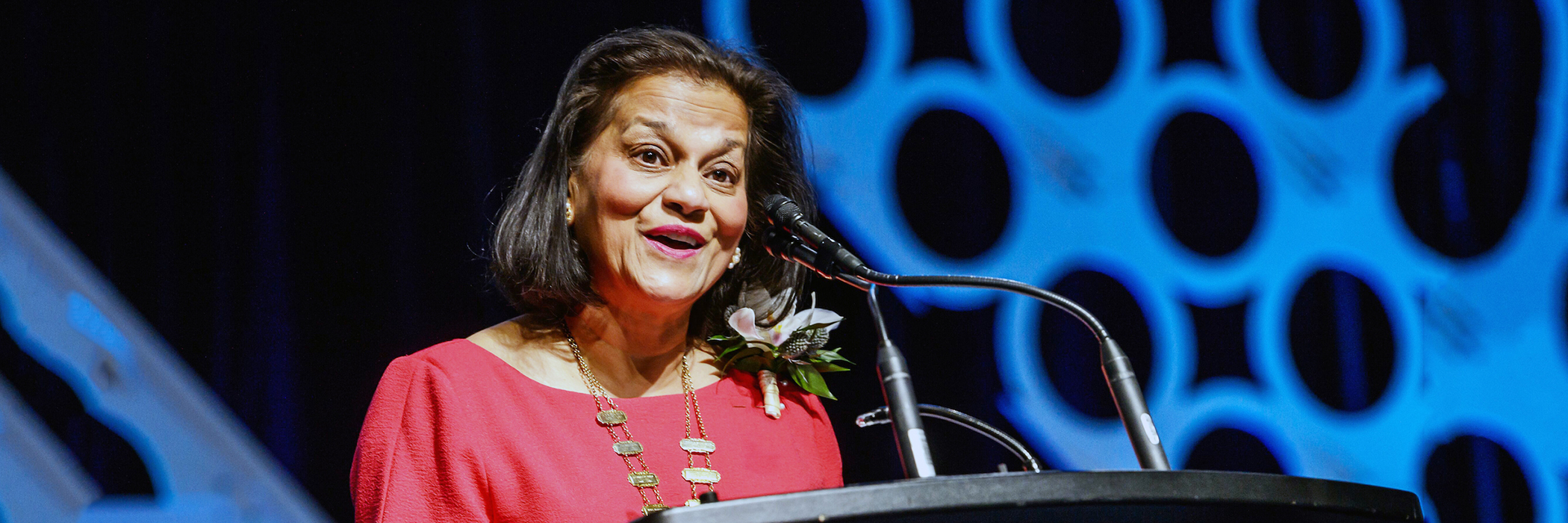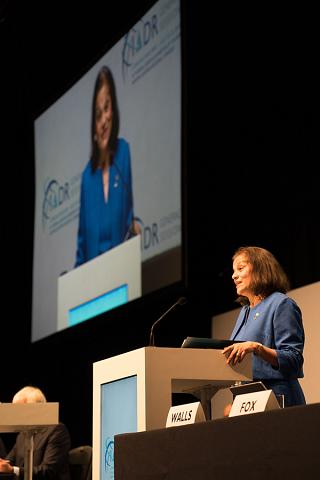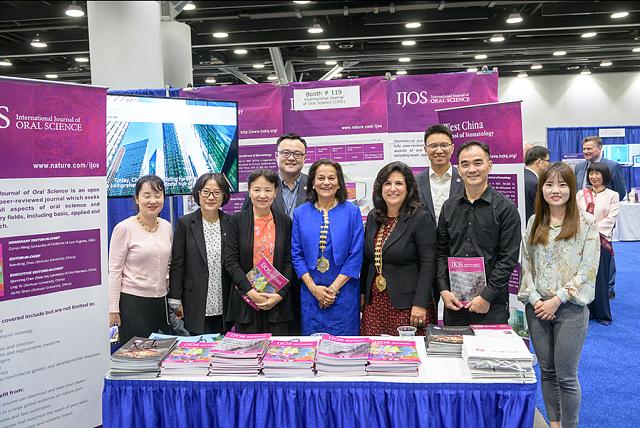Author: Stephen Dark
When Rena D’Souza landed in Addis Ababa, the Ethiopian capital, in September 2017, the soon-to-be-elected 95thpresident of the International Association for Dental Research (IADR) found herself stranded on the airport’s curb. The scent of woodfire drifted through the night air while, across the way, locals slept under blankets. Despite the daunting lack of either the promised reception or an airport official, D’Souza determinedly tracked down an English-speaking security guard who helped her secure a shuttle bus downtown.
The victim of a scheduling glitch at the airport, D’Souza found herself stood up a second time on the same trip, after a colleague had arranged to take her to see “Lucy,” the world’s oldest female skeleton, only to not show up at the hotel to pick her up. The encounter would have spoken to evolution in the cultural as well as biological sense, as D’Souza has trail-blazed for women in her profession. University of Utah Health’s assistant vice president of academic affairs and education for health sciences has served as a role model for minorities and women in dentistry, working at home and around the world to bring about change in a profession long seen as a male bastion.
Paula Moynihan, PhD, who assumed the presidency of the IADR from D’Souza in July 2019, says her predecessor is more than just a respected oral health scientist with an international reputation: “she has a passion for supporting and promoting women in science.” And that role extends to the land of D’Souza’s birth, along with other low- and middle-income countries. “Young trainees looked up to me as the first Indian in this position and the first Indian female,” she says in precise British-English, a hold-over from her formative boarding school years in India. “In those countries, women still do a lot behind the scenes.”
The IADR claims 11,500 members from more than 100 countries, and D’Souza’s presidency in 2018-2019 marked a time of both symbolic and real change. “I came on board at the end of the IADR’s first century and beginning of the next century,” she says. Under her stewardship, she made it one of her central tasks to push for greater research in dental schools at a time of shrinking resources for much-needed oral health investigations.
D’Souza’s greatest contribution to dentistry and global oral health may yet await in the form of groundbreaking research into cleft palates. “She’s found a way to intervene before birth to bring about a fusion of the secondary palate using a natural biomedical intervention,” says Wyatt R. Hume, DDS, PhD, and University of Utah Health’s dean of dentistry. “Bringing about fusion before birth will be a great boon to mankind.”
What The Heart Wants
One of five siblings raised in Mumbai (then called Bombay), D’Souza’s parents valued independence and education—even as her mother gave up teaching to raise her children. In an autobiographical profile, D’Souza writes that her mother “taught us the value of having our own identity in life, our own goals and achievements.”
“We weren’t raised in the traditional Hindu model but rather always orientated towards the west,” she recalls in a boardroom dominated by oil painting portraits of former U of U Health presidents. D’Souza credits her mother for engraining “into my genome that education is of prime importance—and so is giving back to those in need.”
With her background as a pianist, D’Souza was already good at hand-to-eye coordination when she finished dental school at age 22 (the Indian system permits students to complete their dental studies four years before their U.S. counterparts). She moved to the United States in 1978 after marrying a naval architect, Richard D’Souza, who worked in a Houston-based energy and deepwater technology business. In her autobiographical sketch, she writes, “Richard was the reason I moved to Houston. So, my heart dictated my career moves, decisions I never regret.”
She attended the University of Texas Health Science Center at Houston and was later appointed as professor of dental sciences. After serving as Chair of Biomedical Sciences at Baylor College of Dentistry in Dallas, she and her family moved to Utah, where in 2013 she was appointed inaugural dean of University of Utah Health’s School of Dentistry.
When Research Is More Than The Bottom Line
After serving, D’Souza says, in “the trenches” of the IADR in a variety of administrative and editorial positions, she was elected first as president of the American Association of Dental Research, then to the presidency of the IADR in 2018. “It literally opened a window to me to the outside world,” she says.
When her colleague Paula Moynihan started practicing dentistry in northern England in the 1980s, preventive dentistry had yet to take hold. “When Dr. D’Souza was elected as president, there was an increased momentum on the focus of the links between oral and systemic diseases and how the research community needed to think beyond the mouth,” the University of Adelaide-based professor says.
D’Souza’s time as IADR president and her work as a researcher both highlight the fundamental importance of research to addressing global dental and health needs. “She has a passion for improving health and oral health worldwide by supporting and promoting dental research by others,” Hume says.
The World Health Organization ranks untreated dental decay as the number one problem in the global burden of diseases, with four dental diseases ranked in the top 30. D’Souza sought to use the IADR as a platform to underscore how rapidly science and technology are changing. “There are unprecedented opportunities to come up with cures, therapies, and preventions,” she says.
At the same time, dental schools are pulling away from research due to financial pressure. While serving as president of the American Association for Dental Research, D’Souza realized that U.S. institutions were withdrawing from research because it’s typically revenue-neutral. But, she says, research “adds value that is far more qualitative as a distinction, bringing a prominence that allows you to recruit talented people. The bigger benefit is creating knowledge for mankind, including the diagnosis and prevention of diseases that have lingered for years.”
Hume, who served as Australia and New Zealand’s IADR president earlier in his career, salutes D’Souza’s presidency. “She’s probably the most devotedly effective connector I’ve ever seen in the presidency,” he says. “She’s leaving behind a stronger organization because of her energy and devotion.”
Moynihan agrees: “Rena engages people.” She believes that D’Souza is trying to address the concerns and views of its global membership, pushing for a greater focus on strategy, and also implementing important policy changes—notably the IADR’s approach to “healthy meetings” and conduct.
Following several incidents of alleged inappropriate behavior, D’Souza shepherded the board to adopt a zero-tolerance policy. Drawing on results from a members-only survey, she identified the concerns of professional women, like having to deal with unsolicited and unwanted requests from male colleagues to go to their hotel room. “We created a mechanism by which complaints could be resolved and improper behavior stopped,” D’Souza says.
Then there were the sodas and sugar-saturated products served at IADR gatherings. “Is it right to be serving donuts and jelly rolls at meetings?” she mused in disbelief before changing to sugar-free fare. This resulted in an IADR meetings policy “that now promotes fitness and wellness and provides healthier alternatives for food and beverages,” she says.
A Political Voice For Oral Health Care
One question D’Souza sought to address at the IADR was more complex: “How do you harness the power of the international community to move an organization forward when we have so many disparities?” One answer was using the IADR as a forum for sharing knowledge and identifying emerging issues, such as boys contracting throat cancer through an HPV infection resulting from oral sex. Another was health care lobbying by IADR-member researchers. D’Souza cites a cancer researcher in India who influenced government policy to ban a certain type of tobacco.
Part of the challenge of running the IADR is dealing with the many political and cultural differences between member countries. In the U.S., the IADR started a foundation to source travel fellowships and scholarships for dentists who can’t afford the trip to the annual conference. Yet in parts of Europe, philanthropy is not considered a means by which institutions should survive.
A professor at Kings College in London told D’Souza that British politicians simply don’t care what British dentists think, no matter how much they parade signs in front of the House of Parliament proclaiming the dire need for funds for research into oral health.
In her term, the Board developed a tool kit that guides global researchers in how to develop advocacy campaigns that bring both publicity and governmental funding to dental research.
The Key To The Executive Suite
If there was one lesson D’Souza took away from her time at the IADR’s helm, it was the power of a role model. That realization hit her at the opening ceremony for the IADR conference in Vancouver as she stepped down from the stage, her features looming large on the electronic screen above her.
“Do you realize the power that you exuded on stage?” a woman entrepreneur asked her. “You are the most powerful role model we have. We have never had a brown woman or a minority female on stage.”
The origins of dentistry lie with blacksmiths using brute force to pull out troublesome teeth with pliers. It wasn’t until the 1950s that a strong proportion of women began to enter the profession. By then, Hume notes, strength was no longer a requirement: “It became a profession for finesse and fine motor skills.”
In high-income countries such as the UK and Australia, more than 50 percent of dental students are female, a balance that Hume found in California in the 1970s, when he taught at UCLA. Such advancements have yet to reach many low- or middle-income countries—or even the Beehive State. According to 2017 figures from the Utah Medical Education Council, just 4.1 percent of dentists are female. “Utah is an island of the past in this regard,” Hume says.
While D’Souza applauds the 50 percent statistic, she says it’s more complicated than that. “How many women are really in decision-making forums?” she asks. “How many women do you have in the higher executive suites?” Moynihan agrees: “What is fundamental is that we encourage female students to follow research careers and take on leadership positions,” she says. In countries such as Japan and China, D’Souza rallied female faculty and students, noting the “sore lack of opportunity for women to rise up into the ranks of leadership in dentistry.”
Three years ago, when D’Souza floated the idea of dedicating an issue of the IADR’s journal to women, “There were blank stares across the table,” she says. She spent the next year gathering momentum behind the idea. In late 2019, those efforts will bear fruit with the publication of the special centennial issue of “Advances in Dental Research,” which she co-edited. The edition celebrates women who blazed trails for others to follow, including profiles of the 10 women who in the last 20 years have served as IADR presidents.
A Push For The Future
When D’Souza talks about her hopes for eradicating one of the most common birth defects, she pulls up an image of a car seat covered in sweat on a hot day in Germany. In that seat sat one of two twins, Linus and Marten. The children were diagnosed in their mother’s womb with a mutation of the Ectodyplasin gene; D’Souza explains it as being “born with no hair, very few sweat glands, and missing most of your teeth.” After animal tests, a European colleague gained permission from the German government to inject a recombinant protein into the twins’ mother’s amniotic cavity to tackle what D’Souza calls “a glitch in the DNA code.” The injection was successful and the infants were born with their teeth, hair, and sweat glands largely intact.
In the last five years, D’Souza has pursued a similar approach to addressing genetic mutations that cause cranial deformities like cleft palates identified in fetuses. In mice, she her team established “a proof of principal approach to correct cleft palates during development in utero,” she says. “If you simply give it back that little push via utero, it can move on and correct itself.” The next step is to translate it to human trials.
Whether fighting birth defects, eliminating donuts at IADR meetings, or deconstructing the patriarchal values still built into the culture of dentistry in some parts of the world, D’Souza has realized the importance of trying to bring about change. Speaking about cleft palate correction in utero, her words nevertheless resonate much wider. “If you can diagnose it early and strive for a means to correct it, then you offer hope for the future,” she says. “That’s all you can do really."
Photos courtesy of International Association for Dental Research



